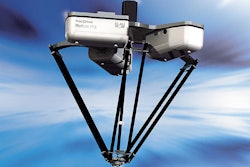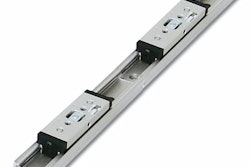As robot technologies continue to improve and evolve, the choices
facing today’s robotics buyers continue to expand as well. How do you
know what type of robot to choose? And more importantly, how can you
avoid mistakes that you may not be aware of, even if you’ve
successfully applied robotics technologies in the past? With
investments ranging from tens of thousands to potentially millions of
dollars, it’s critical to make the right choice the first time, and to
avoid common mistakes that could add substantial, unnecessary costs or
result in project delays. To help engineers and manufacturing personnel
avoid the worst pitfalls, I’ve gathered up the Top Ten robotics
application mistakes I’ve seen in my experience in the automation
business.
Mistake 1: Underestimating Payload and Inertia Requirements
The number one application mistake made by robot users is
underestimating the payload associated with a given application. The
most common cause is failure to include the weight of the end-of-arm
tool in the payload calculation. The second most common cause is
underestimating or completely ignoring the inertia forces generated by
off-center payloads. Inertia forces can overload a robot axis. It is
very common to overload the rotational axis on a SCARA robot. Failure
to correct the problem may also cause damage to the robot.
Reduction in the payload and/or reduction of speed parameters could
remedy the situation. Reducing the speed, however, may cause an
unwanted increase in cycle time—a cycle time that may have been part of
the ROI calculations used to justify the purchase of the robot in the
first place. That’s why it’s critical to consider all load-related
factors from the very beginning.
Mistake 2: Trying To Do Too Much With the Robot
Sometimes the awesome capability and flexibility of a robot can cause a
designer to over-task the robot and make the work cell too complex. The
result once again could be failure to make cycle time, or it could lead
to extremely difficult programming solutions, or even to difficulties
with processor speed limitations. This mistake is further magnified
when users other than the system designer try to troubleshoot the work
cell once in production. Unplanned downtime can be very costly in a
production environment.
Another common manifestation of over-tasking the robot cell is known as
“Project Creep”—adding work beyond the original tasks for which the
robot and work cell were designed. This can be especially disappointing
if the additional tasks are added after a simulation has been performed
verifying the original assumption. If no new simulation is done before
proceeding with the project, the intended cycle time may not be
reached. Be careful not to increase the scope of work of the work cell
beyond the robot’s capability within a given cycle time.
Mistake 3: Underestimating Cable Management Issues
As simple as it may seem, cable management is often overlooked,
possibly because it seems so simple. However, optimizing cable routing
to end-of-arm tooling or peripheral devices is crucial for unrestricted
movement of the robot mechanic. Failure to design out this potential
problem can lead to unnecessary movements of the robot to avoid
tangling or stressing wires. Also, failure to use dynamic cables or to
minimize cable stresses can lead to broken wires and down time.
Mistake 4: LOSTPED, or Failure to Consider All Application Elements before Choosing a Robotics System
Bosch Rexroth uses the acronym LOSTPED to describe the application
elements required to size a mechanical system. By working through these
considerations for each application, you will be sure to consider the
application from every possible angle will avoid mistakes during
planning that could result in severe cost overruns when the system is
installed. You may even discover that you need to consider a different
type of robotics solution altogether; you may discover, for example,
that you need a Cartesian system as opposed to a SCARA robot or
six-axis robot.
The LOSTPED elements are:
Load – consider the payload, orientation and movement;
Orientation – consider the plane of travel, potential obstacles in the
plane of travel, and any impact on lubrication and maintenance
Speed – consider speed, acceleration and deceleration and the inertia they create
Travel – consider the length of travel, alignment, and lubrication intervals
Precision – consider travel accuracy and final position
Environment – consider environmental temperature, cleanliness, and the presence of corrosive agents
Duty Cycle – consider the proportion of time operating and not operating, and any thermal effects on components.
Mistake 5: Misunderstanding Accuracy Vs Repeatability
An accurate mechanic can be repeatable but a repeatable mechanic may or
may not be accurate. Repeatability is demonstrated by returning
accurately to a taught position point in the work envelope of the
robot. Accuracy is demonstrated by moving precisely to a calculated
point in the work envelope. Pallet commands use a robot’s accuracy
capability by calculating an array of robot positions based on a few
taught points. Accuracy is directly related to the mechanical
tolerances or precision of the robotic arm.
Mistake 6: Choosing a Robotics System Based Solely On the Control System
Most robot manufacturers would agree that much more consideration is
given to the robot controller than to the mechanic. This is ironic
because once the robot is deployed, the uptime is mostly dependent upon
the robustness of the mechanic. Loss of production throughput is less
likely to be caused by a broken controller (an electronic device) than
a broken mechanic. Most often a robotics system is chosen based on the
familiarity of the user with the controller and the software. If the
robot in question also has a top-notch mechanic, then this is a
competitive advantage. If, on the other hand, the robot needs constant
servicing after installation, then any time savings from controls
familiarity will be quickly squandered.
Mistake 7: Failure to Accept Robotics Technology
A machine builder or an integrator may create a robot work cell
adequate for an application, but if the end-user fails to embrace the
robotics technology, the project will be doomed to failure. The uptime
of any production equipment is directly related to how well users
understand the equipment and to their ability to maintain the
equipment. The same is true for robot technology.
It is not uncommon for new robot users to refuse robot training. Fully
understanding the capabilities of a robot and “Best Practices” for a
given brand is crucial to a smooth integration.
Mistake 8: Overlooking the Need for Crucial Robot Options or Peripheral Devices
Teach Pendants, communication cables, and even special software options
are all examples of items that may be needed, but forgotten at the time
of the initial order. The lead-time for such items and the cost may
delay the project and cause it to go over budget.
Be sure to compare competitive robot products accurately before
purchase, and be sure to consider all aspects of integration and the
need for any such optional equipment.
It is not unusual at all to find a user attempting to save money by
integrating a robot without options critical to the robot’s overall
performance.
Mistake 9: Under- or Overestimating the Capabilities of a Robot Controller
Underestimating the capabilities of a robot controller can lead to
duplication of systems and the incurring of unnecessary costs.
Duplicating safety circuitry is very common.
Overestimating controller capabilities can lead to additional equipment
costs, rework and costly delays. Attempting to control too many I/O,
additional servos or simultaneous routines is a common mistake.
Mistake 10: Failure to Consider Using Robotics Technology
The size of the initial investment, the lack of familiarity with robot
technology, and past failed attempts are all reasons that people
sometimes shy away from using robotics technology. To improve
productivity and gain a lasting competitive advantage, however, it’s
important to look beyond misconceptions such as these. While it’s true
that robotics are not the answer to every single productivity
improvement, robots can certainly help in many situations.
Time to market, increased productivity, operating simplicity,
flexibility, reusability, dependability, precision, controls
capability, and the long-term cost of ownership are all strong reasons
to use robotics technology.
Other mistakes
The previous top-ten mistakes represent a selection of mistakes that
I’ve seen most frequently in the field. But there are many others that
can easily be included:
* Failure to Consider Future Applications for the Robot
* Choosing a Robot Solely On Price
* Not Understanding the Full Capabilities of the Robot before Implementation
* Not Fully Utilizing the Robot's Capabilities
* Believing Robotics Are Too Complicated
* Believing There Is a Perfect Robotics System
Whatever your robotics task, the best advice of all is to work very
closely with your robotics supplier and system integrator. The better
they understand your needs, the more likely you will be to receive a
system that can perform exactly as you’d like it to. My hope is that
these top-ten mistakes will serve as the starting point for these
discussions.
Milton Coleman is manager of product marketing – Linear Motion and Assembly Technologies
Bosch Rexroth Corp. (www.boschrexroth-us.com) Linear Motion and Assembly Technologies Charlotte, NC

























